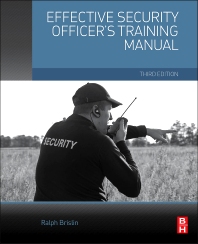Books in Security training
Books in Security training

Active Shooter
- 1st Edition
- Kevin Doss + 1 more
- English

Personnel Protection: Vehicle Operations and Safety
- 1st Edition
- Jerome Miller + 1 more
- English

Personnel Protection: Residential Security
- 1st Edition
- Jerome Miller + 1 more
- English

Personnel Protection: Threat Assessment Profile
- 1st Edition
- Jerome Miller + 1 more
- English

The Effective Security Officer's Training Manual
- 3rd Edition
- Ralph Brislin
- English

Preparing for Next Generation Security Leader Opportunities
- 1st Edition
- Francis J. D'Addario
- English

Personnel Protection: Security Personnel
- 1st Edition
- Jerome Miller + 1 more
- English

Building a Security Measures and Metrics Program
- 1st Edition
- George Campbell
- English

Personnel Protection: Advance Procedures
- 1st Edition
- Jerome Miller + 1 more
- English

Aligning Security Services with Business Objectives
- 1st Edition
- Richard Lefler
- English